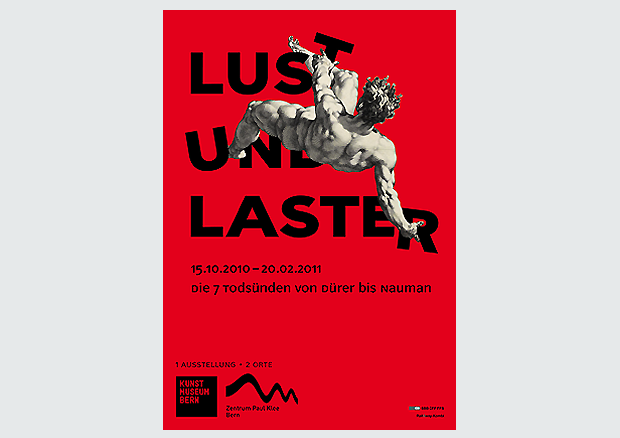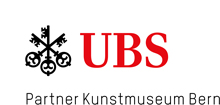1 exhibition, 2 sites - The coproduction with the Zentrum Paul Klee Lust and vice. The 7 Deadly Sins from Dürer to Nauman 15.10.2010 - 20.02.2011
Is lust a sin, is sin lust?
Together the Kunstmuseum Bern and the Zentrum Paul Klee are presenting a collaboratively organized exhibition on the seven deadly sins. The show comprises artworks from 11 centuries – from the 11th century until today. Through the captivating juxtaposition of old with contemporary art, the exhibition traces how the meaning of the seven cardinal sins shifted over centuries, bringing its audience to ponder on the relevance notions of sin still have for us today. Due to the fact that both museums closely cooperated to realize this show, we are not only able to present works from our own holdings but, additionally, highly eminent loans.
The exhibition is divided into eight sections distributed over both
museum buildings. Following an introductory section showing series of
the deadly vices, the sections devoted to superbia (pride/vanity),
invidia (envy), ira (wrath), and avaritia (avarice/covetousness) can be
found in the Kunstmuseum Bern, while acedia (sloth), gula (gluttony),
and luxuria (lust) are located in the Zentrum Paul Klee. Based on
artifacts selected for their historic and cultural relevance, in the
Zentrum Paul Klee we are additionally investigating questions related to society’s acceptance of behavioral patterns and vices today. And not
only this, we also seek to illustrate how certain former sins are now
viewed as affirmative qualities.
Lust and vice yesterday and today
After Christian moral teachings lost their formative influence on
society in the course of the 19th and 20th centuries, it seems logical
to conclude that the concept of the seven deadly sins would now be an
anachronism. But the astounding preoccupation with related subject
matter in artistic, literary, and academic spheres proves that it still
holds undeniable relevance for us today. Following the line of reasoning taken by the exhibition, this is because the deadly sins, from the very beginning, not only served as a means for disciplining Christians in
the name of a higher morality, but also as a kind of safeguard ensuring a functioning society.
General attitudes towards the cardinal vices have changed with social
and economic developments of the previous centuries. At present
society’s approach to the vices is ambiguous. On one hand, we view
greed, envy, or gluttony (in the form of consumerism) as driving forces
within the capitalist economic system. And yesteryear’s promiscuity,
sexual freedom, is socially accepted to a large degree. On the other
hand, we still point a moral finger at such patterns of behavior if they are detrimental to society or threaten to have a destabilizing
influence. We thus decry the greed of managers as rip-off mentality and
criticize the life of consumerist, throwaway society as superficial and
bereft of meaning.
Both old and recent art mirror the ambivalence inherent in notions of
vice. For example, although Dutch artists working in the field of genre
paintings often and preferably represented the vices of humankind, their art is not confined to addressing issues of morality. Instead they
likewise palpably portray sinners’ apparent relish while drinking,
eating, and smoking. Conversely, contemporary art often demonstrates not only delight in breaking taboos, but also the need for moral guidelines and rules of conduct in a world where (nearly) everything is allowed.
Highly eminent artworks
The show presents artworks from 11 centuries – from the 11th century to
now. Manuscripts, prints, paintings, photographs, installations, and
videos impressively reveal the multi-faceted aspects of the canon of
vices.
Due to the collaboration between the Zentrum Paul Klee and the
Kunstmuseum Bern, we have successfully obtained as loans highly eminent
exhibits such as the late 15th-century Antwerp panel depicting a
representation of the Last Judgment as well as a significant number of
Dutch genre paintings from the 17th century by artists such as Adriaen
Brouwer, Jan Steen, Jacob Jordaens, and Adriaen von Ostade. In the show
we are also proud to present works by Peter Paul Rubens, Thomas Couture, Franz von Stuck, Gustav Klimt, Otto Dix, and, of course, Paul Klee.
Besides Bruce Nauman’s installation on the façade of the Kunstmuseum
Bern we are exhibiting a large number of distinguished contemporary
artists (among others Marlene Dumas, Gilbert & George, Andreas
Gursky, Annette Messager, Cindy Sherman, and Erwin Wurm).


